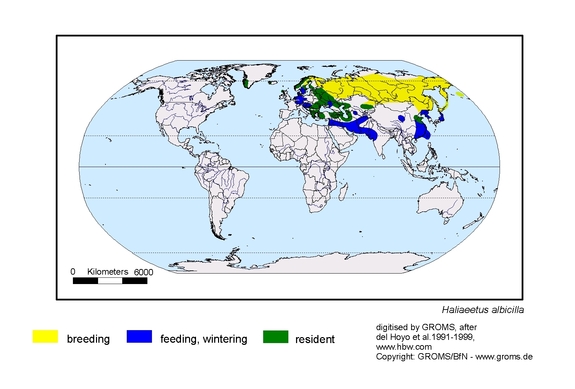
| Species fact sheet | by Global Register of Migratory Species - www.groms.de |
| Use the GROMS database for dynamic search for migratory species, new links and references. |
| Haliaeëtus albicilla | (Linnaeus, 1758) |
| Synonym: | |
| Family: | Accipitridae |
| Order: | Falconiformes |
| English: | White-tailed eagle |
| French: | Pygargue à queue blanche |
| Spanish: | Pigargo europeo |
| German: | Seeadler (There's a German version of this page!) |
| Norwegian: | Havørn (There's a Norwegian version of this page!) |
| Migration: | partial, intracontinental |
| Migration details: | “Mainly migratory in N and E of breeding range; sedentary elsewhere, including Greenland, Iceland and Norway. Juveniles more dispersive and gregarious; in winter can form flocks of 10´s of birds (even 100) in good feeding or roosting areas, e.g. 72 on Hortobagy Plain, Hungary, in Dec 1993. In winter, straggles S from S Sweden through C Europe, rarely to S Europe; in Asia, movements poorly known, with birds occurring from Middle East to E China and Japan. Adults leave N breeding areas later (Oct) and return earlier (Feb-Apr) than juveniles.” del Hoyo J Elliott A & Sargatal J (eds) (1994), Handbook of the birds of the world. Vol. 2: New World Vultures to Guineafowl, p. 122, Lynx Edicions, Barcelona |
| Regions: | East Asia, Europe, North Africa, North America, North Asia, South & Southeast Asia, West & Central Asia |
"After drastic population declines and extinction from extensive areas in the 19th and first half of the 20th century, the current population of the white-tailed eagle is estimated to number between 5000 and 7000 pairs within its range in North and Central Eurasia (Bird Life International 2000). Wintering grounds are known for the Mediterranean, the Persian Gulf, Pakistan, North India and Southeast China (del Hoyo et al. 1994). The species' strongholds are Norway (Bird Life International 2000: 1,600-1,800 pairs) and Russia. For Germany, Hauff (1998) reports a steadily growing population over the past 17 years with 301 breeding pairs in 1997. The same positive trend is reported for the northwest of the white-tailed eagle's breeding range since the 1970s. Numbers are also thought to be stable in countries of the former Soviet Union, but still declining in Southeast Europe (Bird Life International 2000). Main causes of its decline are direct persecution, the use of poisoned baits, and habitat destruction; over the last decades also pollution by organochlorine pesticides and heavy metals (Bird Life International 2000, del Hoyo 1994, Hauff 1998). Due to these threats the white-tailed eagle is considered as "Lower Risk/Near Threatened" (LR/nt) in the recent Red List (Hilton-Taylor 2000) and is included in CMS Appendices I & II."
From: Riede, K. (2001): Global Register of Migratory Species. Weltregister wandernder Tierarten. Münster (Landwirtschaftsverlag), S. 247
Further detailed information from the GROMS-database
Recommended link(s):
| ARKive | White-tailed eagle (Haliaeetus albicilla): description, pictures, movies... |
| www.hawk-conservancy.org | |
| RSPB | The Royal Society for the Protection of Birds |
| www.forestry.gov.uk | Forestry Commission Great Britain |
| Der Spiegel online | (in English) |
| www.birdguides.com | |
| whatBird.com | |
| BirdLife international | "Wind farm causes eagle deaths" - article about the death of several White-tailed eagles on Smøla, a set of islands off the Norwegian coast |
| Oiseaux.net | (in French) |
| Wikipedia | |
To gather more information about birds in general see the link collection at connotea.org: aves
Please help us by updating our link collection via connotea!
Feedback: mail to: Klaus Riede
by Ansgar Tappenhölter